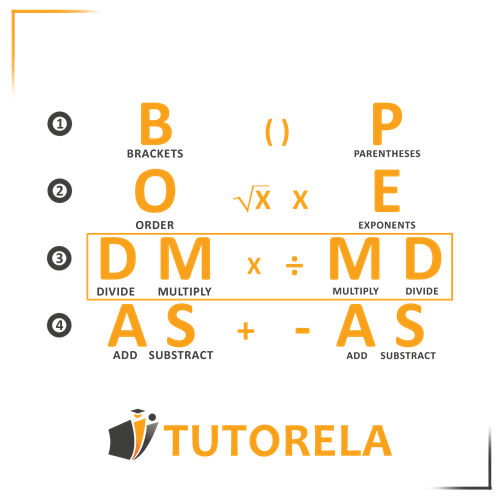Multiplication and division are the second step in the order of operations, immediately after opening parentheses.
Multiplication and division - Examples, Exercises and Solutions
Multiplication and division in order of operations
The first stage -
Opening parentheses and solving everything inside them.
If multiplication and division appear along with addition and subtraction, multiplication and division come first, followed by addition and subtraction from left to right.
Then we rewrite the expression without parentheses.
The second stage -
Multiplication and division in order, from left to right.
We will rewrite the new exercise after solving the multiplication and division.
The Third Stage -
Addition and subtraction in order.
We add and subtract from left to right.

Suggested Topics to Practice in Advance
Practice Multiplication and division
Solve the following expression:
\( 10\times2:4=\text{ ?} \)
\( 10-4 \div 2 = \)
\( 10 \div 2 + 1 = \)
\( 10\div2-4= \)
\( 10 \div 2 \div 1 = \)
Examples with solutions for Multiplication and division
Exercise #1
Solve the following expression:
Video Solution
Step-by-Step Solution
The division and multiplication have the same priority according to the order of operations, therefore we solve it from left to right:
Answer
5
Exercise #2
Video Solution
Step-by-Step Solution
To solve , we follow the order of operations (PEMDAS/BODMAS): Parentheses or Brackets, Exponents or Orders, Multiplication and Division (from left to right), Addition and Subtraction (from left to right).
First, perform the division: .
Next, substitute back into the expression: .
Therefore, the correct answer is .
Answer
8
Exercise #3
Video Solution
Step-by-Step Solution
To solve , follow the order of operations:
- First, perform the division: .
- Then, add 1 to the result: .
Thus, the answer is 6.
Answer
6
Exercise #4
Video Solution
Step-by-Step Solution
To solve the expression , follow the order of operations, which prioritizes division over addition.
Divide by to get .
subtract from : .
Answer
1
Exercise #5
Video Solution
Step-by-Step Solution
First, perform the division: .
Next, divide the result by 1: .
So, the answer is .
Answer
5
\( 10 \div 5 \times 6 = \)
\( 2 + 5 \times 3 = \)
\( 2 \times 5 \times 3 = \)
\( 30:5\times2= \)
\( 3 + 4 \times 2 = \)
Exercise #6
Video Solution
Step-by-Step Solution
To solve , you need to follow the order of operations: first perform the division and then the multiplication.
Step 1: Divide 10 by 5:
Step 2: Multiply the result by 6:
So, the answer is .
Answer
12
Exercise #7
Video Solution
Step-by-Step Solution
According to the order of operations, multiplication should be performed before addition. So, first calculate the multiplication:
Then add 2 to the result:
Therefore, the correct answer is:
Answer
17
Exercise #8
Video Solution
Step-by-Step Solution
First, we calculate the product of the first two numbers: .
Then, we multiply the result by the third number: .
Therefore, .
Answer
30
Exercise #9
Video Solution
Step-by-Step Solution
According to the rules of the order of operations, the exercise which contains both multiplication and division should be solved from left to right.
Answer
12
Exercise #10
Video Solution
Step-by-Step Solution
According to the order of operations, you should first calculate the multiplication, then the addition:
Then add the result to 3:
Answer
11
\( 3 \times 2 \times 4 = \)
\( 4 \times 3 \times 2 = \)
\( 5+4\times2= \)
\( 5 \times 2 + 1 = \)
\( 6 / 2 + 5 = \)
Exercise #11
Video Solution
Step-by-Step Solution
First, we calculate the product of the first two numbers: .
Then, we multiply the result by the third number: .
Therefore, .
Answer
24
Exercise #12
Video Solution
Step-by-Step Solution
First, we calculate the product of the first two numbers: .
Then, we multiply the result by the third number: .
Therefore, .
Answer
24
Exercise #13
Video Solution
Step-by-Step Solution
To solve the expression , we follow the order of operations (PEMDAS/BODMAS).
1. First, we perform the multiplication:
2. Next, we add the result to 5:
Therefore, the final answer is .
Answer
13
Exercise #14
Video Solution
Step-by-Step Solution
First, perform the multiplication operation:
Then add 1 to the result:
Therefore, the correct answer is:
Answer
11
Exercise #15
Video Solution
Step-by-Step Solution
First, perform the division:
Then add 5: